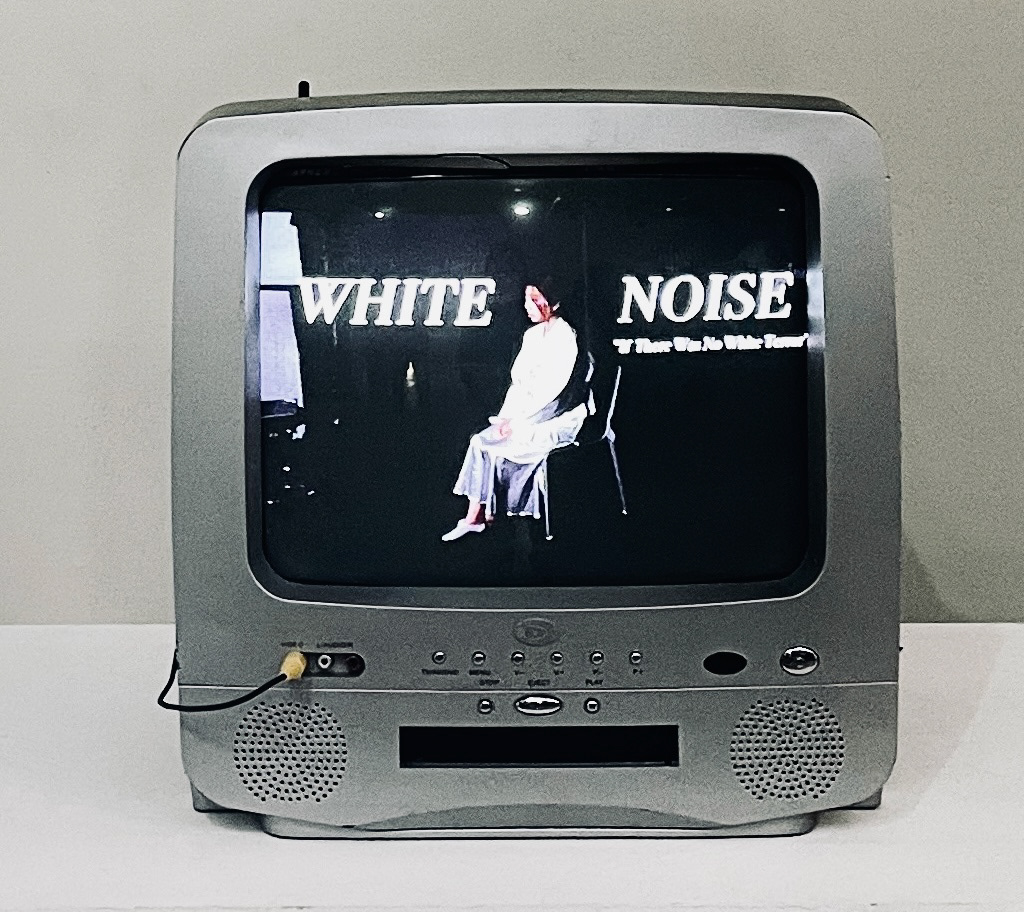“During the White Terror period,
amidst government suppression using state power,
the voices of dissenters were gradually turned into white noise that no one could hear,
dissolving into our lives and history, persisting until today”
Lin Chi-shan
"White Terror" refers to the period of dictatorship that ensued after the Kuomintang (KMT) party retreated from mainland China to Taiwan, spanning from 1949 to 1991. It is estimated that around 200,000 cases of persecution occurred across various locations in Taiwan during this period.

"White Noise: If There Was No White Terror" attempts to simulate the experiences of intellectuals during that time – how victims were imprisoned, judged, and forced to live in a persecutory environment by using photos to recreate the scenes of the process. The second part features a video utilizing the colors of the national flag and KMT’s flag to indicate how the victims were powerless to fight against the country. Additionally, a multi-layered soundtrack aims to evoke the chaos of the atmosphere.
It serves as a reminder for the younger generation that despite nearly 80 years passing and living in a society that embraces democracy and diverse opinions, it's crucial to learn from the experiences of authoritarianism to prevent regression in the democratic process. Building a bridge connecting the past and present to open conversations in society. After all, as the saying goes, "History is the blood buried deep in the soil." We should always remember that and not let the scars of the era replay in today's society.
First Parts: Photos
The first part consists of a series of eight photos. I transformed these photos into digital negatives and printed them in the darkroom. Using bleach, I removed the colors, symbolizing the dictatorship's desire to eradicate all anti-government activities. Then, I used toner to give them the appearance of 1950s photos. The character named 白照茵 (Bái Zhào Yīn) represents the Chinese translation of "white noise."
In the series, 白照茵 (Bái Zhào Yīn) portrays a female student who was taken away from her classroom for joining a study group and reading banned books. She was "accused of treason and sent to prison for ideological reform." In prison, she had to fetch water with a bucket by herself and learn to follow the prison's order and queue.
In the last photo, she regains a brief identity (wearing clothes with a name) and is no longer just a prisoner number. The smile on her face indicates her pride in herself. She loved this land, this country. Therefore, I asked the model to give me a proud, confident, yet slightly regretful smile. There is a bullet mark on her chest, symbolizing the execution by firing squad, which marks the end of the brilliant yet brief life of 白照茵 (Bái Zhào Yīn).
Second part: video
In this video, I use Adobe Premiere to do post processing of both visual and sound to add the noise and vinyl, making it more like retro style to fit the era of 1950. In the beginning, I use a grid divided into nine parts to indicate the sequence of events: 1, 9, 4, 7, 2, 2, 8. Historically, February 28, 1947, marks the beginning of social unrest and the government's desperate efforts to maintain its power.
The second section features a monologue serving as an introduction to the era characterized by the absence of freedom of speech. The atmosphere of terror and scars from that period continue to linger today.
The third section explores the symbolism of colors. The national flag of the Republic of China (ROC) is based on the flag of the Kuomintang (KMT), both featuring a white sun on a blue background, with the ROC flag adding a red background. Both flags were designed by Lu Haodong and Sun Yat-sen, the founding father. Visually, I use blue as a metaphor for the KMT and red for the citizens. The transition from red to blue, akin to the light spectrum, signifies the KMT's retreat from mainland China to Taiwan. The use of violence and restrictions on people's thoughts and freedoms led to resistance and bloodshed. However, the eventual resurgence of the blue color symbolizes the people's powerless resistance.
“The air of freedom is not something we breathe in effortlessly;
it is fought for by groups of Taiwanese people.
These faces on the streets are all nameless heroes
who have contributed to the achievement of democracy and freedom in Taiwan” (Xie Santai,2023)
"White Noise: If There Was No White Terror" attempts to simulate the experiences of intellectuals during that time – how victims were imprisoned, judged, and forced to live in a persecutory environment by using photos to recreate the scenes of the process. The second part features a video utilizing the colors of the national flag and KMT’s flag to indicate how the victims were powerless to fight against the country. Additionally, a multi-layered soundtrack aims to evoke the chaos of the atmosphere.
It serves as a reminder for the younger generation that despite nearly 80 years passing and living in a society that embraces democracy and diverse opinions, it's crucial to learn from the experiences of authoritarianism to prevent regression in the democratic process. Building a bridge connecting the past and present to open conversations in society. After all, as the saying goes, "History is the blood buried deep in the soil." We should always remember that and not let the scars of the era replay in today's society.